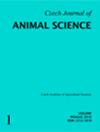基因型、泌乳期和气候因素对牛乳脂肪酸谱的影响
IF 1.4
4区 农林科学
Q3 AGRICULTURE, DAIRY & ANIMAL SCIENCE
引用次数: 1
摘要
来自牛乳的乳脂含有可能对人体健康有益的脂肪酸,例如,共轭亚油酸(CLA)具有营养保健活性。本研究旨在了解基因型、哺乳天数和气候因素对乳汁脂肪酸(FA)分布,特别是乳脂中CLA含量的影响。选取17头初产乳奶牛进行泌乳评价;Gyr杂交12个,F1 (Holstein/Gyr)杂交5个。从泌乳期开始至泌乳期结束(300 d),每隔15天采样一次。采用气相色谱法对脂肪酸进行分析。基因型对饱和脂肪酸(SFA)、单不饱和脂肪酸(MUFA)、多不饱和脂肪酸(PUFA)和多不饱和脂肪酸(CLA)的含量没有影响。泌乳100天MUFA和PUFA含量最高,分别为32.334 g/100 g FA和3.553 g/100 g FA,泌乳200天SFA和CLA含量最高,分别为63.238 g/100 g FA和1.378 g/100 g FA。气候方面,最高温度导致CLA含量下降,因为温度高于30℃导致放牧时间减少。本文章由计算机程序翻译,如有差异,请以英文原文为准。
Effect of genotype, lactation and climatic factors on fatty acid profile of bovine milk
Milk fat from bovine milk contains fatty acids that may have favourable properties for human health, for example, conjugated linoleic acid (CLA) has nutraceutical activity. This research aimed to know the effects of genotype, days of lactation and climatic factors on the fatty acids (FA) profile of milk and particularly the content of CLA in milk fat. Seventeen first-calving milking cows in early lactation were used for the assessment of milk; 12 were Gyr and five were F1 (Holstein/Gyr) crosses. Sampling was carried out every 15 days, from the beginning to the end of lactation (300 days). Fatty acids were analyzed employing gas chromatography. The genotype did not influence the content of the fatty acid groups: saturated fatty acids (SFA), monounsaturated fatty acids (MUFA), polyunsaturated fatty acids (PUFA) and CLA. The highest MUFA and PUFA contents were recorded at 100 days of lactation (32.334 and 3.553 g/100 g of FA, respectively), while SFA and CLA had their highest production at 200 days of lactation (63.238 and 1.378 g/100 g of FA, respectively). Regarding the climate, the highest temperature caused a decrease in the CLA content, because temperatures above 30 °C caused a decrease in the grazing time.
求助全文
通过发布文献求助,成功后即可免费获取论文全文。
去求助
来源期刊

Czech Journal of Animal Science
Agriculture, Dairy & Animal Science-奶制品与动物科学
CiteScore
2.40
自引率
16.70%
发文量
44
审稿时长
5 months
期刊介绍:
Original scientific papers and critical reviews covering all areas of genetics and breeding, physiology, reproduction, nutrition and feeds, technology, ethology and economics of cattle, pig, sheep, goat, poultry, fish and other farm animal management. Papers are published in English.
 求助内容:
求助内容: 应助结果提醒方式:
应助结果提醒方式:


